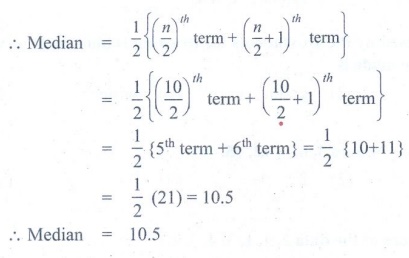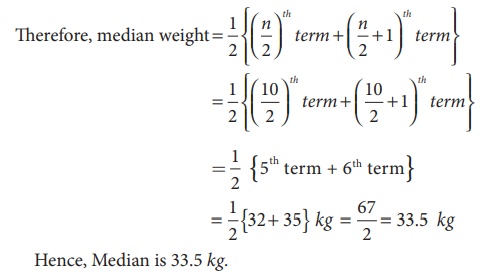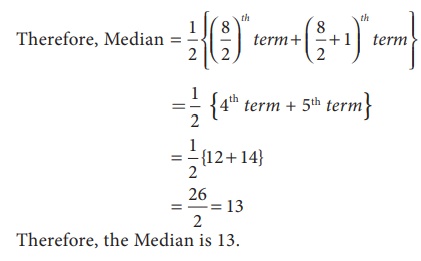Statistics | Term 3 Chapter 5 | 7th Maths - Median | 7th Maths : Term 3 Unit 5 : Statistics
Chapter: 7th Maths : Term 3 Unit 5 : Statistics
Median
Median
We have discussed the situations where
arithmetic mean and mode are the representative values of the given data. Let us
think of any other alternative representative value or measures of central tendency.
For this let us consider the following situation.
Rajam an old student of the school wanted
to provide financial support to a group of 15 students, who are selected for track
events. She wanted to support them on the basis of their family income. The monthly
income of those 15 families are given below.
₹ 3300, ₹ 5000, ₹ 4000, ₹ 4200, ₹ 3500, ₹ 4500, ₹ 3200, ₹ 3200, ₹ 4100, ₹ 4000, ₹ 4300, ₹ 3000, ₹ 3200, ₹ 4500, ₹ 4100.
Rajam would like to give them an amount
to their family.
If we find the mean, we get
Arithmetic mean, A.M = sum of all values
/ 15
= [ 3300 + 5000 + 4000 + 4200 + 3500 + 4500 + 3200 + 4100 + 4000 + 4300 + 3000 + 3200 + 4500 + 4100] / 15

= 58100/15 = 3873.3
Can the amount of ₹ 3873.3
be given to all of them irrespective of their salary? Is ₹ 3873.3
is the suitable representative here? No, this is not suitable here because a student
with family income ₹ 3000 and a student with family income
₹ 5000
will receive the same amount. Because the representative measure used here is not
sutable for the above data, let us find the mode for this data.

Here mode is 3200 which means there are
more number of students with a family income of ₹ 3200. But this does not
suite our purpose.
Hence, mode is also not suitable. Is
there any other representative measures that can be used here? Yes.
Let us look at another representative
value which divides the data into two halves exactly. First, let us arrange the
data in ascending order.
That is, ₹ 3000,
₹ 3200,
₹ 3200,
₹ 3200,
₹ 3300,
₹ 3500,
₹ 4000,
₹ 4000,
₹ 4100,
₹ 4100,
₹ 4200, ₹ 4300, ₹ 4500, ₹ 4500, ₹ 5000.
After arranging the income in ascending
order, Rajam finds 8th value ( ₹ 4000) which divides the data into two
halves. It helps her to decide the amount of financial support that can be given
to each of the students. Note that ₹ 4000 is the middle most value.
This kind of representative value which
is obtained by choosing the middle item is known as Median.
Thus in a given data, arranged in ascending
or descending order, the median gives us the middle value.
Consider another example, where the data
contains even number of terms 13, 14, 15, 16, 17 and 18. How to find the middle
term for this example? Here the number of terms is 6, that is an even number. So
we get, two middle terms namely 3rd and 4th term. Then, we take the average of the
two terms (3rd and 4th term) and the value we get is the median.
That is, Median =
1/2 {3rd term + 4th term}
=1/2 {15 + 16}
= [ 15+ 16 ] /2 = 31/2 = 15.5
Here, to find median we arrange the values
of the given data either in ascending or descending order, then find the average
of the two middle values.
So we conclude that, to find median,
(i) arrange the data in ascending or
descending order.
(ii) If the number of terms (n) is odd,
then ([n + 1]/2)th term is the median
(iii) If the number of terms (n) is even,
then average of ( n/2)th and ([n/2] + 1)th terms is the median.
Try these
1.Find the median of 3, 8, 7, 8, 4, 5, 6.
Solution:
Arranging in ascending order: 3, 4, 5, 6, 7, 8.8.
Here n = 7, which is
odd.

Hence the median is 6.
2. Find the median of 11, 14, 10, 9, 14, 11, 12, 6, 7, 7.
Solution:
Arranging in ascending order: 6, 7, 7, 9, 10, 11, 11, 12, 14, 14
Here is n = 10, which
is even.
Median

Median = 10.5
Activity
Create a group of 6 to
7 students and collect the data of weight of the students in your class. In each
group find mean, median and mode. Also, compare the averages among groups. Are they
same for all the groups?
Also find all the three
averages for entire class. Now, compare the results with the average of each of
the groups.
Example 5.10
Find the median of the following
golf scores. 68, 79, 78,
65, 75, 70, 73.
Solution:
Arranging the golf scores in ascending
order, we have, 65, 68, 70, 73, 75, 78, 79
Here n = 7 , which is odd.
Therefore, Median = ([n+1] / 2)th
term
= ([7+1] / 2 )th
term.
= (8 /2)th term
= 4th term = 73
Hence, the Median is 73.
Example 5.11
The weights of 10 students
(in kg) are 35, 42, 40, 38, 25,
32, 29, 45, 20, 24 Find the median of their weight?
Solution:
Arranging the weights in ascending order,
we have, 20, 24, 25, 29, 32, 35, 38, 40, 42, 45
Here, n = 10 , which is even.

Hence, Median is 33.5 kg.
Example 5.12
Create a collection of 12
observations with median 16.
Solution:
As the number of observations is even,
there are two middle values.
The average of those values must be 16.
We will now find any pair of numbers
whose average is 16. Say 14 and 18.
Now an example of data with median 16
can be 2, 4, 7, 9, 12, 14, 18, 24, 28, 30, 45, 62.
Note
We can find more than one
answer for this question
Example 5.13
The lifetime (in days) of
11 types of LED bulbs is given in days. 365, 547, 730, 1095, 547, 912, 365,
1460, 1825, 1500, 2000. Find the median life time of the LED bulbs.
Solution:
Arranging the data in ascending order,
we have, 365, 365, 547, 547, 730, 912, 1095, 1460, 1500, 1825, 2000.
The number of observations are 11, which
is odd.
Median ={ [n+1] / 2} th term
= {[11+1] /2}th term
= 6th term = 912
Therefore, the median is 912.
Hence, the median lifetime of the LED
bulb is 912 days.
Example 5.14
Find the Median of the following data.
12, 7, 23, 14, 19, 10, 5, 26
Solution:
Arranging the data in ascending order,
we have
5, 7, 10, 12, 14, 19, 23, 26.
Here, n = 8 , which is even.

Therefore, the Median is 13.
Think
Complete the table given
below and observe it to answer the following questions.


(i) Which are all the series
having common mean and median?
Solution: A,
B and C.
(ii) Why median is same
for all the 4 series?
Solution:
Since the middle value is 100.
(iii) How mean is unchanged
in the series A, B and C.
Solution: The
difference between the given numbers are equal.
(iv) What change is to
be made in the data, so that mean and median of ‘D’ series is equal to other series?
Solution: If
99 becomes 0 or 200 becomes 101 then mean becomes 100.
Related Topics